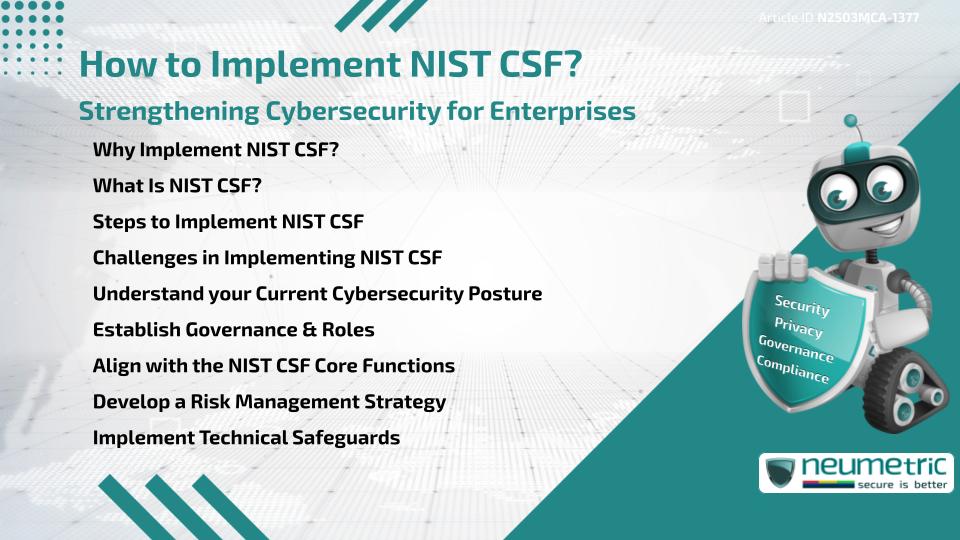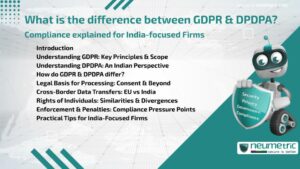Table of Contents
ToggleIntroduction
Cybersecurity is a critical concern for Businesses of all sizes. As digital threats continue to grow, Frameworks like the National Institute of Standards & Technology Cybersecurity Framework [NIST CSF] offer a structured approach to safeguard Information & Systems. The NIST CSF provides guidelines that can help Enterprises address Cybersecurity Risks more effectively. But how do Organisations implement this Framework successfully? In this article, we will walk you through how to implement NIST CSF, why it matters & the practical steps to strengthen your Cybersecurity Posture.
What Is NIST CSF?
The National Institute of Standards & Technology Cybersecurity Framework [NIST CSF] is a set of guidelines & best practices designed to help Organisations manage & mitigate Cybersecurity Risks. It is widely recognised for its flexibility, allowing Businesses to adapt the Framework to their unique Needs & Risk Environments. The NIST CSF consists of five (5) core functions:
- Identify: Understand the Organisation’s Cybersecurity Risks.
- Protect: Implement safeguards to Limit or Contain the impact of Cybersecurity Events.
- Detect: Identify the occurrence of Cybersecurity Events in a timely manner.
- Respond: Take action to contain the impact of Cybersecurity Events.
- Recover: Develop Plans for resilience & recovery after an Incident.
These functions form the backbone of any Cybersecurity strategy, helping Businesses establish a comprehensive Risk Management approach.
Why Implement NIST CSF?
Adopting the NIST CSF offers several advantages, making it a popular choice for Enterprises aiming to enhance their Cybersecurity Frameworks.
Historical Perspective
The NIST CSF was first introduced in 2014, developed by a collaboration between NIST & Private Industry to address increasing concerns over cyber threats. Since then, it has gained widespread acceptance & has been adopted by both Large Enterprises & Small Businesses alike. This broad adoption speaks to its effectiveness & reliability in addressing Cybersecurity challenges.
Practical Perspective
For Organisations, the NIST CSF offers practical, actionable steps that can be tailored to the size, structure & risks of each Enterprise. It provides a comprehensive, Risk-based approach, which is far more adaptable than rigid, prescriptive Security Policies. Whether a Business is looking to improve existing Security Measures or build a Framework from scratch, the NIST CSF provides valuable direction.
Diverse Perspectives
From a diverse perspective, the flexibility of the NIST CSF allows it to be applicable across various Industries, including Healthcare, Finance & Government. This adaptability is key in ensuring that all sectors can benefit from a structured, yet flexible approach to Cybersecurity.
Steps to Implement NIST CSF
Implementing the NIST CSF requires a thoughtful, systematic approach. Here are the core steps Businesses should follow:
1. Understand your Current Cybersecurity Posture
Before you begin implementing the NIST CSF, assess your Organisation’s current Cybersecurity Environment. This includes identifying Existing Risks, Vulnerabilities & Areas that require Improvement. The NIST CSF suggests that Organisations start by determining their Risk Tolerance & the level of Security Controls needed to address those risks.
2. Establish Governance & Roles
Assign key Personnel who will oversee the Implementation Process. This includes Cybersecurity Managers, Compliance Officers & IT Staff. Creating a Cybersecurity Governance Structure ensures accountability & clear responsibility for the various aspects of the Framework.
3. Align with the NIST CSF Core Functions
The Core Functions of the NIST CSF provide a Roadmap for Cybersecurity. Start by addressing each of the five (5) Functions & Mapping your existing practices to them. This will help you identify Gaps in your current Systems & Policies, allowing you to make the necessary adjustments.
4. Develop a Risk Management Strategy
Risk Management is at the heart of the NIST CSF. Develop a strategy that includes Risk Identification, Assessment, Mitigation & Monitoring. This will help you prioritise resources & focus efforts on areas with the highest potential impact.
5. Implement Technical Safeguards
Once the strategy is in place, focus on implementing the Technical & Administrative safeguards that will protect your Organisation’s Assets. This includes Firewalls, Intrusion Detection Systems, Encryption & Employee Training Programs.
6. Monitor, Detect & Respond
Ongoing Monitoring & Detection are essential components of the NIST CSF. Implement systems to detect Cybersecurity Threats in real-time & establish a Response Plan to quickly address any incidents that occur. A well-prepared response can minimise the damage from Cyberattacks.
7. Review & Improve
Cybersecurity can not be considered a one-time effort but a Continuous Process. Regularly Review & Update your strategies to ensure they remain effective against evolving threats. The NIST CSF encourages Organisations to continually assess their Security Posture & make adjustments as needed.
Challenges in Implementing NIST CSF
While implementing the NIST CSF provides many benefits, there are several challenges Businesses may face:
Resource Constraints
Implementing the NIST CSF can be resource-intensive, especially for Small to Medium-sized Enterprises. Budget limitations & a lack of Skilled Cybersecurity Professionals can hinder efforts to adopt the Framework effectively.
Complexity
The NIST CSF is comprehensive, which can make it overwhelming for Organisations to implement all aspects at once. Breaking down the Framework into smaller, manageable steps is key to overcoming this challenge.
Integration with Existing Systems
Integrating the NIST CSF with existing Cybersecurity Policies & systems can be difficult, particularly for Organisations that have already established a Security Infrastructure. Compatibility & Alignment between old & new systems require careful Planning & Coordination.
Conclusion
Implementing the NIST CSF is a critical step in strengthening your Organisation’s Cybersecurity Posture. By following a structured approach, Businesses can create a more resilient Security Infrastructure. Although there are challenges in the process, the benefits of improved Security, Risk Management & Compliance far outweigh the initial effort.
Takeaways
- A structured approach is provided by NIST CSF to manage Cybersecurity Risks.
- It consists of five (5) core functions: Identify, Protect, Detect, Respond & Recover.
- Implementing the NIST CSF requires Assessing current Risks, Assigning Roles & Aligning Practices with the Framework’s Functions.
- Regular reviews & improvements are essential to maintaining an effective Cybersecurity Strategy.
FAQ
How long is it estimated to implement NIST CSF?
The time required to implement the NIST CSF depends on the size of your Organisation & its current Cybersecurity Posture. It can take anywhere from a few months to over a year for large Enterprises.
Can small Businesses implement NIST CSF?
Yes, the NIST CSF is flexible & can be scaled to meet the needs of Businesses of all sizes. Small Businesses can adopt the Framework step-by-step & tailor it to their unique Resources & Risk Environment.
How much does it Cbr {mso-data-placement:same-cell;}How to implement NIST CSF? Strengthening Cybersecurity for Enterprisesost to implement NIST CSF?
The Cost of implementing the NIST CSF can vary based on your Organisation’s size & the resources required. Small Businesses may incur lower costs if they already have basic Security Measures in place.
How do I measure the success of NIST CSF implementation?
Success can be measured through improved Risk Management, reduced Security Incidents & enhanced Compliance with Regulatory Requirements. Regular Audits & Assessments can help gauge progress.





